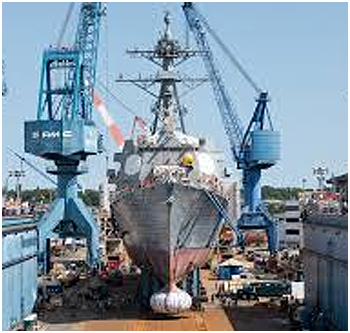





![]()
![]()
![]()
![]()
![]()
![]()
![]()
![]()
![]()
![]()
![]()
![]()
![]() You are here > Home > News Columns > Bringing Shipbuilding to the Galveston-Houston Region
You are here > Home > News Columns > Bringing Shipbuilding to the Galveston-Houston Region
The Executive Branch Must Act Within Its Authority
| Previous Getting the U.S. Debt & Shipping Under Control |
Bringing Shipbuilding
To the Our Region
| Next The Kennedy Nomination: Follow the Money | |
|
Published in the Galveston County Daily News January 28, 2025 In 2022, the United States exported $2.1 trillion in goods and $926 billion in services, that's $3.02 trillion total. In 2023 that increased to $3.05 trillion. The US is the second largest trading nation in the world, second only to the Communist Chinese. Over 75% of our consumption comes from goods and services from overseas. We import more than we export, causing trade imbalances. Implications: We are paying foreign interests -- not US producers -- for what we consume; causing a debt in the form of trade deficits. Additionally, the U.S. has become a weaker nation because we are not producing large amounts of what we consume here at home. This is a national economic and national security concern. For example, we import most of our pharmaceuticals like antibiotics, blood thinners, and cancer drugs from China and India. Why not produce them here in the U.S.? USA exports account for about 10% of our Gross Domestic Product (GDP) – what we produce. Most of our exports go to Mexico, Canada, China, Japan, and the United Kingdom. We are the world's third largest exporter but our economy is less trade-oriented than many other nations. Globally the average trade-to-GDP is 63% while the U.S. it's closer to 27%. If you only count containerized shipping, the Houston/Galveston port is the sixth most active in the nation. According to the Bureau of Transportation Statistics, if you look at ALL exports – including petrochemical exports – our port leads the nation in total exports. The ports of Houston/Galveston are one of the few that export more than we import, the leader of 43 U.S. ports that handle exports.  But there's a problem! The U.S. has only 80 vessels in its merchant marine – down from 2,500 after World War II -- and by 2027 that number will be reduced to 55. Compare that to the 5,500 merchant vessels in Communist China's service. Additionally, we need mariners to run them. TAMG Superintendent Col. Mike Fossum tells us that there is a greater need for merchant mariners than his school can provide. But there's a problem! The U.S. has only 80 vessels in its merchant marine – down from 2,500 after World War II -- and by 2027 that number will be reduced to 55. Compare that to the 5,500 merchant vessels in Communist China's service. Additionally, we need mariners to run them. TAMG Superintendent Col. Mike Fossum tells us that there is a greater need for merchant mariners than his school can provide. The U.S. has only 2% of the shipbuilding capability of the entire world; much of this is constructing vessels for the U.S. Navy. Most commercial shipbuilding now takes place in China, Japan, and South Korea. For national security reasons the U.S. drastically needs to increase its number of shipyards and its shipbuilding capabilities. There's general agreement about this but many are saying, "Not in my backyard!" The Houston-Galveston area would be a prime location for having a new shipyard but there are some major hurdles. One is where to put it? Pelican Island might be a possibility or perhaps further up the channel. Another hurdle is a lack of experienced shipbuilders, mechanics, pipefitters, and other personnel it takes to staff such a facility. There needs to be a concerted effort to train up such a workforce. Finally, if we were to have such a facility, how do we protect it against hurricanes? In tandem with working toward the goal of getting a first class and modern shipbuilding facility here in the Houston-Galveston region we need to move forward with construction of the coastal barrier. Like the Ike Dike, we need to develop a groundswell of public support in order to make this happen. LCDR Sargent is a twenty-year U.S. Navy veteran and is a member of the Houston Bay Area Economic Partnership – Maritime Subcommittee. He also served for over twenty years at the U. S. Department of Commerce focusing on international trade issues. |
|||
About the Author 2025 Bill Sargent has written or cowritten over 300 guest columns and editorials over the last ten years and continues to do so. Bill lives in Galveston, Texas |
|||
| . | |||